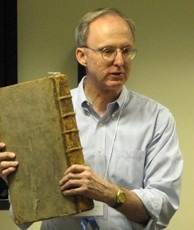G-10. Introduction to the Principles of Bibliographical Description
David R. Whitesell
“I feel much more confident in my understanding of format and how it relates to book structure, as well as in my ability to create an in-depth analysis of an ideal copy.” — 2017 student
Course Length: 30+ hours
Course Week: 27 July–1 August 2025
Format: in person, University of Virginia in Charlottesville, VA
Fee: $1,595
This course is intended for those seeking a better understanding of best practices for the physical examination and description of printed books, especially of the period 1550–1900. It is designed both for students with little formal exposure to this subject and for those with some general knowledge who seek a systematic discussion of the elements of descriptive bibliography as set forth in Fredson Bowers’ Principles of Bibliographical Description.
Each class day is divided into four sessions: lecture, museum, lab, and description practice. Lectures cover methods of determining format and drafting collational formulas, and of describing paper, type, and the circumstances of publication (edition, issue, and state), with a coda on the history, application, and future of descriptive bibliography. During museum sessions, students familiarize themselves with the materiality of print by handling a wide range of printed books and other materials—tools and equipment, examples, self-teaching packages, and the like—drawn from the celebrated Rare Book School collections. A key part of the course consists of small group lab sessions in which students practice the determination of format and collation and the description of signings and pagination under an expert instructor’s guidance. During description practice, students prepare individually for the lab sessions by working with progressively more difficult examples of books in various formats which present a variety of descriptive challenges. Students should plan to devote three hours each evening (Monday – Thursday) to description practice onsite; they should also commit themselves to a significant amount of advance preparation.
In their personal statement, applicants should describe the extent of their background in bibliography, the nature of their interest in the subject, and how they expect to apply what they learn. There is no formal prerequisite for the course, though students with little prior exposure to pre-1900 books may be directed to other Rare Book School course(s) before being admitted to G-10.
Note on the differences between the “Printed Books: Description & Analysis” courses (G-20 and G-30) and this course (G-10).
This course (G-10) and the “Printed Books” courses (G-20 and G-30) cover similar ground. G-10, however, focuses more intensively on format, collation, and the rigorous description of both hand- and machine-press period books through description practice and lab sessions; it also emphasizes self-study of physical features and terminology through museum sessions. Its primary text is Fredson Bowers’ Principles of Bibliographical Description, supplemented by Philip Gaskell’s A New Introduction to Bibliography.
In the “Printed Books” courses, Gaskell serves as the principal text. G-20 and G-30 are intended for collectors, booksellers, librarians, educators, and others who seek an introduction to the physical features of printed books—presented in a more traditional, interactive seminar setting—but who do not wish to spend extended time on the study of format and collational formulas. Students in all three courses enjoy extended contact with Rare Book School’s renowned study collections of books, bindings, and related artifacts.
If you anticipate the need to prepare your own bibliographical descriptions, including accurate collational formulas, you may find G-10 more suited to your needs. If a broader overview, combined with the ability to interpret bibliographical descriptions, would better suit your career plans or personal interests, then either of the “Printed Books” courses would be a good fit. Because of the overlap in course content, Rare Book School discourages students from applying to a “Printed Books” course and G-10 in the same year; however, students who complete either of the “Printed Books” courses are welcome to apply to G-10 in subsequent years, but not vice versa. Students who take G-10 will find themselves well prepared for the Advanced Descriptive Bibliography course (G-50).
Please note: the tuition for this course is $1,595 owing to the expenses associated with a larger faculty.
Click here to view the course description for the virtual version of this course, “Descriptive Bibliography: The Fundamentals.”
Course History
Faculty

David R. Whitesell
David R. Whitesell retired as Curator in the Albert and Shirley Small Special Collections Library at the University of Virginia in 2022. He previously worked as Curator of Books at the American Antiquarian Society, Rare Book Cataloger at the Houghton Library, Harvard University, and in the antiquarian book trade. He has served as Secretary of the Bibliographical Society of America and as a Trustee of the American Printing History Association. His publications include First Supplement to James E. Walsh’s Catalogue of the Fifteenth-Century Printed Books in the Harvard University Library (2006); he also was Associate Editor for Spain, Portugal, and Latin America for the Oxford Companion to the Book (2010), and Editor of Roger Stoddard’s A Bibliographical Description of Books and Pamphlets of American Verse Printed from 1610 Through 1820 (2012; winner of the MLA Prize in Bibliography). Among the exhibitions he has curated are In Pursuit of a Vision: Two Centuries of Collecting at the American Antiquarian Society (2012) and A Curator’s Wunderkammer: A Decade of Collecting for the University of Virginia (2022).
